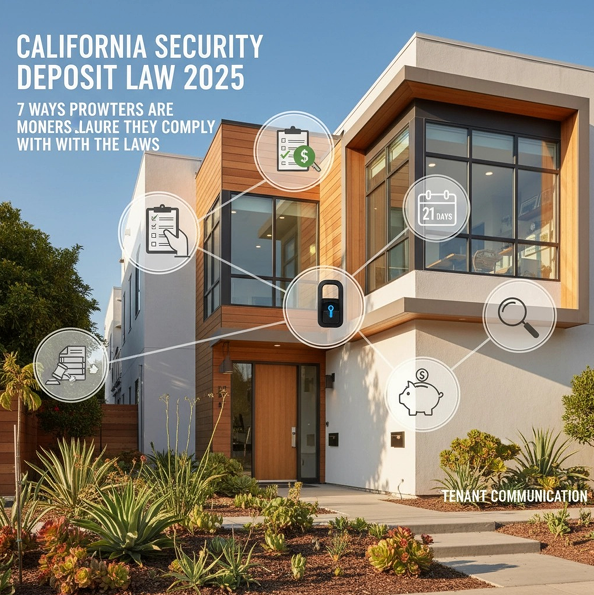How to Manage a Multi-Family Property in Los Angeles: The Complete 2025 Guide

Managing multi-family properties in Los Angeles is not for the faint of heart. A confluence of regulatory shifts, market dynamics, and evolving tenant expectations has created a dynamic landscape that demands sharper execution. LA’s intricate web of rent control ordinances, layered with California’s expanding tenant protections, requires owners to master compliance while still protecting NOI. If it feels like running a Class A asset in a Class Z rulebook, you’re not wrong—just in the right place for solutions.
To win in 2025, you must master LA’s three-tier regulatory system, deploy technology that systematizes operations, and stay ahead of market trends reshaping the multifamily sector. This guide distills what matters most so you can maximize returns while navigating the regulatory maze that defines Los Angeles real estate.
Understanding LA's Three-Tier Rent Control System
LA’s regulatory framework meaningfully impacts strategy, cash flow, and exit options. Your obligations hinge on the building’s construction date, which places you into distinct categories with very different rules—and very different ceilings on revenue.

Pre-1978 Properties: The RSO Challenge
Pre-October 1, 1978 multifamily assets fall under the Rent Stabilization Ordinance (RSO)—the heavyweight champion of constraints. Annual rent increases are capped at 3% for the base amount, with an additional 1% if you cover utilities, for a maximum 4% increase in 2025–2026.
RSO is more than rent caps. Owners face just-cause eviction requirements, mandatory relocation assistance payments that can hit $22,000 per unit, and extended notice periods that can slow necessary turnovers by months. It’s a sustained assault on landlords’ ability to respond to market conditions and maintain competitive returns—so strategy and documentation must be airtight.
Post-1978 Properties: Navigating AB 1482 and JCO
Post-1978 properties escape RSO rent caps but remain under the Just Cause Ordinance (JCO) and statewide AB 1482. AB 1482 limits annual increases to 5% plus CPI, with a 10% ceiling. Flexibility improves relative to RSO, but JCO’s just cause eviction and relocation assistance rules still apply. Translation: more room to maneuver, but not a free-for-all.
Single-Family Rentals: The Exemption Advantage
Single-family homes and condos benefit from broader exemptions, though “exempt” does not mean “hands-off.” Understanding these distinctions is vital for portfolio strategy, underwriting, and hold period planning.
Essential Management Strategies for Maximum ROI
In a constrained environment, operational discipline is the alpha. The playbook: systematize, document, and communicate—relentlessly.
Establishing Operational Excellence
Publish clear tenant guidelines covering noise, parking, pets, and common-area use, with specific enforcement mechanisms. Document policies and uniformly apply them across all units. Consistency reduces disputes, improves tenant expectations, and protects you during conflicts. Think SOPs, not ad hoc decisions.
Proactive Communication Systems
Implement structured communication protocols: regular property updates, maintenance notifications, and policy reminders. Use multiple channels—email, text, and online portals—to increase reach and create an auditable record. This lowers the odds that small issues become code violations or agency complaints. Fewer surprises for tenants; fewer headaches for you.
Strategic Maintenance Management
Run a proactive maintenance program: quarterly inspections, seasonal checklists, and preventive schedules for major systems. Build a bench of licensed contractors who know LA’s rules and timelines. Scope jobs clearly, price competitively, and track SLAs. Preventive work beats emergency calls every time—for habitability compliance, cost control, and asset preservation.

Leveraging Technology for Competitive Advantage
In LA’s high-regulation environment, tech isn’t optional—it’s the operating system. The right stack centralizes rent collection, automates late fees, and streamlines tenant communication while maintaining meticulous records.
Modern platforms deliver robust reporting essential for RSO and city compliance, from rent increase tracking to turnover documentation for HCIDLA. Online maintenance portals create the paper trail you want when habitability questions arise. Integration with accounting ensures clean expense tracking for tax treatment and potential capital improvement deductions. Documentation is not busywork here; it’s your shield.
Digital Documentation and Compliance
Digitize everything: lease files, addenda, notices, inspections, and city correspondence. Cloud-based storage gives you quick access during inspections or legal proceedings, with the security and redundancy you need. In a market where records win disputes, digital precision is a profit center.
Navigating Legal Compliance in 2025
The regulatory environment continues to expand, adding cost and complexity to day-to-day operations. Owners who treat compliance as a workflow—not a fire drill—avoid fines and stay focused on performance.
State-Level Requirements: SB 721 and Beyond
Senate Bill 721 mandates inspections of balconies and other exterior elevated elements for multifamily properties. Budget for recurring assessments and potential repairs; the liability exposure justifies the rigor. Assembly Bill 2579 layers additional safety requirements into your operating checklist. Build these into your annual plan, not a rainy-day list.
Local Compliance Challenges
LA’s Department of Building and Safety continues to widen inspections and sharpen enforcement. Track deadlines, keep certificates current (fire safety, elevators where applicable), and audit your records quarterly. Systematic compliance prevents the kind of unforced errors that turn into four-figure fines and attorney hours.

Market Intelligence and Strategic Positioning
Macroeconomic factors may move capital costs, but LA’s multifamily fundamentals remain firm. Occupancy reached 95.8% in Q2 2025, up 0.3% quarter-over-quarter—evidence of durable demand despite regulatory friction.
Rent Growth Projections and Submarkets
Expect moderate rent growth of 2–3% across LA County in 2025, supported by limited new supply and steady demand from young professionals and growing families. Within the guardrails, pricing strategy matters: work the allowable increases methodically to sustain returns.
Submarket nuance drives outcomes. The Westside—Santa Monica, Culver City, Venice—commands a premium with low vacancy. The San Fernando Valley delivers resilient workforce housing demand. Downtown LA presents adaptive reuse opportunities in an evolving core. Match capital plans to submarket realities, not headlines.
Investment and Acquisition Considerations
Underwrite by regulatory tier. RSO assets can offer lower basis but tighter operational constraints; post-1978 properties often trade higher but provide more flexibility under AB 1482 and JCO. Align hold strategy, capex, and revenue planning with the regulatory envelope you’re actually buying—not the pro forma wish list.
Professional Management vs. Self-Management Decision Framework
Both paths can work. The right choice depends on unit count, your time, and your appetite for compliance complexity.
When Professional Management Makes Financial Sense
Experienced managers navigate LA’s regulatory maze daily, often saving owners thousands in avoided violations and legal spend. They maintain vetted vendor benches, price work competitively, and calibrate rents within constraints. Expect fees of 5–10% of gross income; the ROI case typically includes fewer compliance hits, higher tenant retention, and better execution on capital plans.
Self-Management Success Strategies
If you self-manage, treat it like an operating business: master local regulations, build process checklists, and keep immaculate documentation. Own the calendar—inspections, renewals, notices—and keep a reliable contractor network on speed dial. Hybrid models also work: self-manage the routine, consult professionals for complex compliance or contested issues.

Successful self-management hinges on staying current with regulatory changes, maintaining digital file discipline, and monitoring performance metrics monthly. The less you leave to memory, the better your margins.
Positioning for Long-Term Success
LA’s multifamily market offers durable demand, but the rulebook is unforgiving. Owners who blend tenant satisfaction with operational rigor outperform over the cycle.
Prioritize retention to reduce turnover costs and vacancy loss—especially where rent control limits new-lease upside. Invest in improvements that residents feel: lighting, plumbing fixtures, common area refreshes, and smart entry—while staying alert to potential pass-throughs where allowed.
Strategic Capital Improvements
Plan capex with intent. Energy efficiency upgrades, seismic work, and accessibility improvements can unlock regulatory allowances in specific scenarios and enhance long-term competitiveness. Sequence projects to minimize downtime and maximize resident goodwill.
The confluence of regulatory complexity, strong fundamentals, and rising tenant expectations creates challenges worth solving. Owners who systematize compliance, professionalize operations, and plan capital strategically can convert constraints into a competitive moat.
Treat compliance not as a burden but as part of the business model—one that protects cash flow, preserves optionality, and compounds value over time. In LA’s high-bar environment, disciplined operators don’t just survive; they outperform.
Related Links
1. Internal Links
2. Authoritative External Links
- City of Los Angeles Housing Department
- California Department of Real Estate
- Official California Legislative Information
- HUD: Rental Assistance & Tenant Resources
- California Courts: Small Claims Info for Landlord/Tenant Disputes
3. Local Community Links
Share this post
Contact Us



